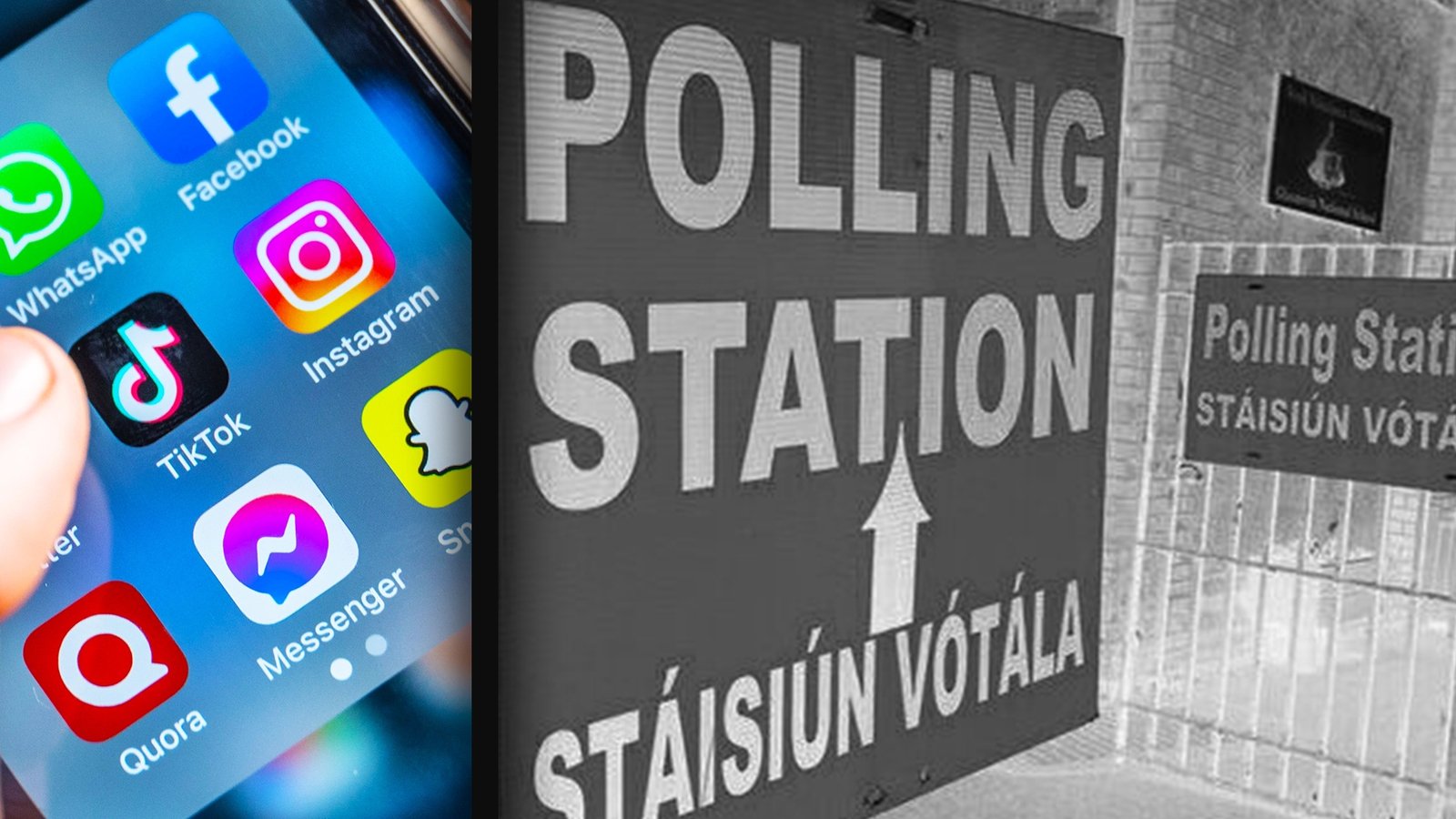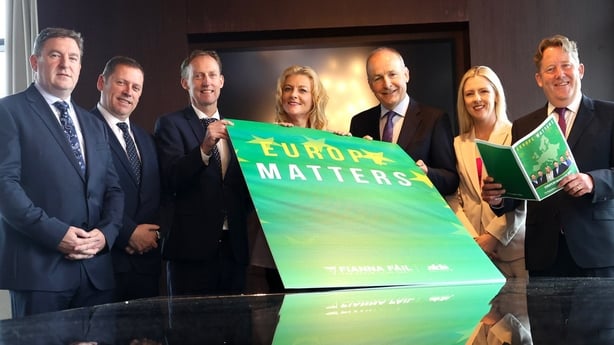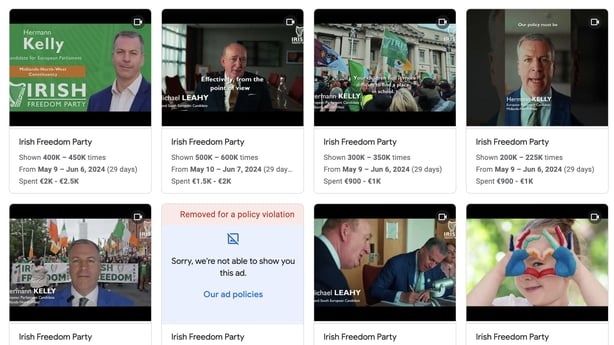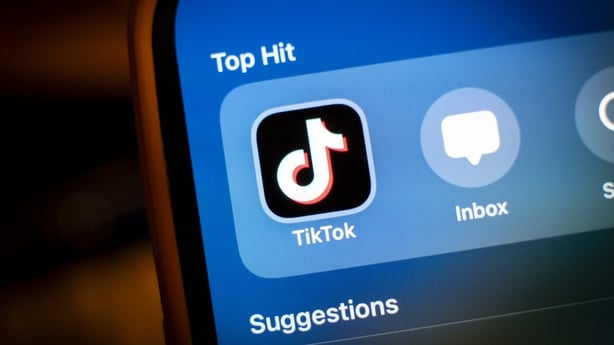Who spent what on online ads to try to sway your vote?

Spending from political organisations and candidates on online ads soared in recent days, as campaigns drew to conclusion, according to data disclosed by online platforms under EU law.
More than €14,700 was spent on Thursday – the final full day of the campaign – on Google ads alone by Sinn Féin and its candidates. Data for spending on Meta covers until Monday (3 June); in the week prior to that day the party spent around €5,500 per day on such ads. Meta is the company which operates Facebook and Instagram.
Some €6900 was spent placing ads on Meta by Fine Gael HQ and candidates on this day last week alone, with a further €6400 and €5700 spent on each of the following days, Sunday 2 June and Monday 3 June. That compares to about €1700 spent by Fine Gael per day on Meta in the early weeks of last month.
Fianna Fáil also ramped up its digital spending from around €2000 daily to around €5000 in the final days of the campaign. Other parties made similar moves, most doubling their spending rates from around 27 May, ten days out from the vote.
The data on declared political spending shows the main platforms that Irish parties and candidates focused on for advertising were Meta and Google.
Around €500,000 was spent in total on Meta, from 11 March to 3 June, with another €100,000 on Google, according to Who Targets Me, a pro-transparency advocacy organisation that tracks digital ad spending.
Ads posted via Meta appear on Facebook and Instagram, while Google platforms include YouTube, Google Search and Google display ads, which appear across partner websites.
Platforms such as LinkedIn and TikTok don’t allow political advertising. Under Elon Musk ownership, X – formerly known as Twitter – now allows political ads, but researchers who spoke to Prime Time described the data as difficult to properly assess.

The EU’s Digital Services Act requires social media platforms and search engines to clearly label political ads. This is intended to allow people to see why they were targeted, who sponsored the ad, how much they paid, and which elections or referendum it refers to.
Sensitive data such as ethnicity, religion, sexual orientation cannot be used to target voters.
So how does the spending breakdown and what does it tell us about the campaigns?
Meta spending
From 11 March – the Monday after the Family and Care referendums – to 3 June, at least €510,970 was spent by political entities, according to Who Targets Me.
It identified about 700 advertisers in Ireland running political ads.
We need your consent to load this Datawrapper contentWe use Datawrapper to manage extra content that can set cookies on your device and collect data about your activity. Please review their details and accept them to load the content.Manage Preferences
In the Meta ads library, each advert is listed as having been published by a page. A page could be controlled by the party centrally, a branch of a party, or individual candidates.
Some 57 pages associated with Sinn Féin spent €130,260 on Meta platforms.
According to Sam Jeffers, the founder of Who Targets Me, such a scale of online spending is not surprising. Sinn Féin has “always been the biggest single party page spender,” he said.
Fianna Fáil was next with 93 pages associated with the party spending €98,659. Fine Gael was third, with 81 active pages spending €93,208
The figures then drop, with the Labour Party next highest with €45,979 across 3 pages.
Who Targets Me also identified 66 pages associated with independent candidates or smaller parties, which spent a combined total of €40,815. Independent Ireland candidate Niall Boylan topped the spending list within that category at €5,900.
The top five spending pages associated with individual candidates were Fianna Fáil’s Cynthia Ní Mhurchú (€18,198); Fine Gael’s Nina Carberry (€17,626), Sinn Féin’s Chris MacManus with (€13,289); Labour’s Aodhán Ó Ríordáin (€11,189) and Fine Gael’s Maria Walsh with €11,176.

Transparency campaigner Liz Carolan, who publishes The Briefing, a newsletter on technology and politics, says the pattern of spending provides insights into the campaign.
“Sinn Féin really ramped up their spending. Fina Gael [was] a little bit slower to follow, but I think in the last week have actually overtaken Sinn Féin now in daily spending.”
“Fianna Fáil – they have… a real lack of consistency across the candidates. So, some big spenders, some very, very low spenders,” Ms Carolan told Prime Time.
Sinn Féin, she said, were “running a very centralised campaign, with a lot of their ads. 75% of their ads come from the main Sinn Féin headquarters account.”
“For Fine Gael, only about 10% of their spend is going through the kind of official Fine Gael branded account, the other 90% is going through candidates’ accounts,”
She added that a consistency in messaging and production style from Fine Gael candidates on their individual pages indicated “that the candidates are getting a lot of help from [Fine Gael] HQ and this would be in line with when we look at spending data from previous elections, the fact that Fine Gael tend to help their candidates quite a lot.”
Fianna Fáil had a similar pattern, Ms Carolan said, whereby most of the funding was spent through the candidates’ pages.
When it comes to content and messaging, Mr Jeffers of Who Targets Me says the biggest spenders, Sinn Féin, “go quite big on cost-of-living type of things.”
“I noticed this week, they started to have a couple of ads that mentioned immigration possibly for the first time, and sort of saying, ‘hey, we’re not quite as permissive as you might expect,’” he said.
How political parties target voters in Ireland tends to be quite simple, according to the experts who spoke to Prime Time.
It is “pretty geographical, maybe a bit of age-based targeting. You know, they’re not doing anything necessarily too sophisticated,” Mr Jeffers said.
“Particularly around things like farming issues…[parties] are targeting people interested in tractor brands and, you know, dairy farming, dairy cattle farmer, owner-operator as a job title and things like this.”
Spending on Google Platforms
The other popular platform to advertise on has been Google, through its network of websites and platforms like YouTube.
We need your consent to load this Datawrapper contentWe use Datawrapper to manage extra content that can set cookies on your device and collect data about your activity. Please review their details and accept them to load the content.Manage Preferences
Data from Google’s ad library shows that €99,650 was spent on 8,006 political ads shown in Ireland from 11 March to 6 June, far less than the near €500,000 spent with Meta.
The biggest spender was again Sinn Féin, who spent €47,550 on 14 ads displayed across the advertising network. Including the surge of more €14,700 spent on Thursday alone.
“The money isn’t necessarily going and reaching lots of people, it’s going on reaching the right people who they see as being very important,” Ms Carolan said.
“On YouTube [specifically], the biggest advertiser is actually the Irish Freedom Party, who are a very small party, but who’ve been able to dominate that platform and reach up to 300,000 people with YouTube ads,” Ms Carolan told Prime Time.
Irish Freedom Party spent €6,650 on 16 ads on YouTube across the campaign.
Data on the Google ads library shows that neither Fine Gael nor Fianna Fáil ran centralised ad campaigns.
However, Hopkins Communication spent €1,550 on six ads for Fianna Fáil candidate Billy Kelleher in the Ireland South constituency.
The EPP Group of the European Parliament, which Fine Gael is a member of, also spent €8,300 on seven ads visible to Irish users, while the Renew Europe group, which Fianna Fáil is affiliated with, spent €3,600 on 13 ads.

The Big Picture
All the ads mentioned above appear in ads libraries and have therefore been declared and approved by the platforms. Ms Carolan however warns that other ads may also have appeared for users which were not properly moderated or declared correctly, including on other platforms.
Despite requirements under the Digital Services Act, she says many of the platforms’ ad repositories make it difficult to track who is spending what, if the candidates or parties simply don’t tick certain boxes.
TikTok says it does not allow political advertising but during the final week of the campaign it was criticised for allowing 16 test political ads to be published targeting voters in Ireland containing false information.
The investigation from campaign group, Global Witness, said the ads approved on TikTok contained false information relating to the closure of polling stations due to outbreaks of infectious diseases; the promotion of incorrect ways to vote such as by text message and email; and incitements to violence against immigrant voters.
As part of its research, Global Witness created political ads to see how TikTok, YouTube, and X, formerly Twitter, treat election disinformation, which new EU rules require platforms to mitigate.
X halted all the ads while YouTube rejected all but two. TikTok approved every ad for publication. After the reviews, the group withdrew the misleading ads.
Political advertisements for local candidates running in Ireland were also found on TikTok, in breach of their policy not to allow such ads. TikTok said it removed the ads in question.

Prime Time also found an ad for a National Party candidate that appeared to be shown by Google ads but was not visible in its ad library. In response to a query by Prime Time, Google said it would “review the ad in question against our policies and will take any appropriate action.”
For Liz Carolan, these are examples of how ads can slip through the net.
“When everybody plays by the rules, you can find and scrutinise that activity, but for activity that’s clandestine or breaks rules or doesn’t want to be found where we need transparency most, it’s the hardest,” she said.
“It is hard to find ads that don’t want to be found, that aren’t being run by official campaigns or candidates.”
TikTok accepted that all 16 of the ads that Global Witness submitted violated its advertising policies. It said “they were approved due to human error on the part of one moderator. That moderator has since received retraining, and we have instituted new practices for moderating ads.”
Having more transparency around political online spending is key, Ms Carolan believes.
“This isn’t just about regular content or candidate speech. This is about the payment of money in order to reach and influence voter behaviour. If we don’t have visibility of this, we can’t have accountability over what is increasingly a very large percentage of expenditure.”
“We can’t follow the money, we can’t understand who’s trying to influence politics in Ireland and we can’t then – when the returns come out – connect up the dots and see is somebody spending money they shouldn’t have been spending?”



